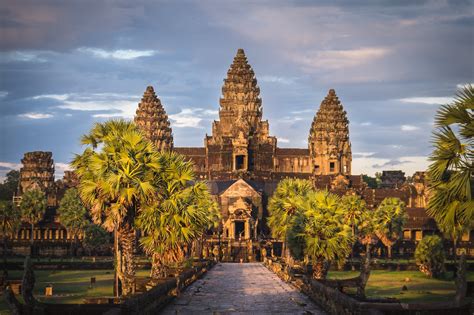Nestled within the lush jungles of Cambodia lies the ancient and awe-inspiring temple complex of Angkor Wat. As one of the world’s most treasured and significant archaeological sites, Angkor Wat is a testament to the rich history and cultural heritage of the Khmer Empire. In this blog post, we will embark on a virtual journey through Cambodia’s past as we uncover the enchanting temples of Angkor Wat.
From the intricate carvings and towering spires to the sprawling courtyards and labyrinthine passageways, the architectural marvels of Angkor Wat are a testament to the ingenuity and craftsmanship of the ancient Khmer people. We will explore the iconic temples that make up this sprawling complex, each with its own unique history and significance.
But with the passage of time and the threats of environmental degradation and tourism, the preservation and protection of Angkor Wat’s legacy have become crucial. We will delve into the efforts being made to safeguard this UNESCO World Heritage site for future generations to marvel at and cherish. So, join us as we unearth the mysteries and wonders of Angkor Wat, a journey through Cambodia’s ancient history.
Introduction to Angkor Wat
Angkor Wat is a world-renowned temple complex located in Cambodia, which was built by the Khmer Empire in the early 12th century. It is the largest religious monument in the world and is considered one of the most important archaeological sites in Southeast Asia. The complex spans over 400 acres and consists of several temples, reservoirs, and canals.
Visitors to Angkor Wat can explore its rich history, intricate carvings, and stunning architecture, which reflects the Hindu and Buddhist influences of the time. The main temple is dedicated to the Hindu god Vishnu, and the entire complex is designed to represent Mount Meru, the home of the gods in Hindu mythology.
Angkor Wat has been a UNESCO World Heritage site since 1992 and continues to attract millions of visitors each year. It has also been a source of national pride for Cambodians and has appeared on the country’s flag since the 19th century.
Today, Angkor Wat remains an important symbol of Cambodia’s cultural and religious heritage, and efforts are ongoing to preserve and protect this iconic site for future generations to enjoy and appreciate.
Unearthing the Mysteries of Angkor Wat
Angkor Wat, the largest religious monument in the world, is shrouded in mystery and intrigue. Archaeologists and historians have long been fascinated by the ancient city of Angkor, and the secrets it holds. Unearthing the mysteries of Angkor Wat is a daunting task, but one that has captivated the imaginations of scholars and adventurers alike for centuries.
The sprawling complex of Angkor Wat is a testament to the ingenuity and skill of the ancient Khmer people. From the intricately carved bas-reliefs to the towering spires, every inch of Angkor Wat holds clues to its rich history and cultural significance. As archaeologists continue to unearth hidden chambers and artifacts from the site, new discoveries shed light on the enigmatic world of Angkor Wat.
One of the greatest mysteries of Angkor Wat is the purpose of its construction. While it is widely believed to have been a temple dedicated to the Hindu god Vishnu, some archaeologists and historians propose that it may have served a different function altogether. The architectural marvels of Angkor Wat continue to spark debate and intrigue as experts work tirelessly to unravel the secrets of this awe-inspiring site.
Preserving and protecting the legacy of Angkor Wat is of utmost importance as more mysteries are brought to light. As the site continues to yield new discoveries, it is essential to ensure that its cultural heritage is safeguarded for future generations. Unearthing the mysteries of Angkor Wat is an ongoing journey, one that promises to yield even more fascinating insights into this ancient wonder.
Architectural Marvels of Angkor Wat
One of the architectural marvels of Angkor Wat is the grandeur and intricacy of its design. The temple complex is comprised of multiple layers, each more awe-inspiring than the last. From the imposing outer walls to the intricate carvings adorning the interiors, every detail of the architecture is a testament to the skill and dedication of the craftsmen who built it.
Another architectural marvel of Angkor Wat is the perfect alignment of the entire complex with the cardinal points. The main temple is oriented to the west, while the entrance faces to the east, allowing for a breathtaking view of sunrise and sunset, making it not only a religious landmark but also a stunning celestial observatory.
The sheer size of the architectural marvel is also worth mentioning. Covering an area of over 200 hectares, Angkor Wat is the largest religious monument in the world. The scale of the temple complex is truly staggering, and it’s hard to comprehend the immense manpower and resources required to construct such a marvel in ancient times.
Lastly, the innovative use of materials in the construction of Angkor Wat is a true architectural marvel. The temple was built using a technique called sandstone quarrying, where massive blocks of sandstone were quarried and transported to the site for assembly. This feat of engineering, combined with the intricate carvings and bas-reliefs, makes Angkor Wat a true wonder of architectural achievement.
Exploring the Iconic Temples of Angkor Wat
Angkor Wat is one of the most iconic and breathtaking temple complexes in the world. The sheer size and scale of the site is enough to leave any visitor in awe, and the intricate carvings and architectural details only add to its mystique. Exploring the temples of Angkor Wat is a journey through history, culture, and religion, and each temple has its own unique story to tell.
The first temple that visitors usually encounter is the famous Angkor Wat temple itself, which is the largest religious monument in the world. Walking through the halls and corridors of this ancient temple, visitors can marvel at the elaborate carvings that depict scenes from Hindu epics and ancient Khmer civilization. The symmetrical design and intricate details are a testament to the skill and creativity of the Khmer people.
Another must-visit temple is Bayon, known for its many smiling faces carved into the stone. This temple is a unique and fascinating example of Khmer architecture and art, with its soaring towers and intricate bas-reliefs. Exploring the narrow passages and hidden corners of Bayon is an adventure in itself, as visitors discover the stories and legends depicted in the carvings.
As visitors continue to explore the iconic temples of Angkor Wat, they will encounter other magnificent structures such as Ta Prohm, where ancient trees have intertwined with the ruins, creating an eerie and captivating atmosphere. The rich history and cultural significance of these temples make them a truly remarkable destination for travelers seeking to immerse themselves in the wonders of the ancient world.
Preserving and Protecting Angkor Wat’s Legacy
Angkor Wat, the largest religious monument in the world, is not just a tourist attraction; it is a symbol of Cambodia’s rich cultural heritage and history. As such, it is crucial to preserve and protect this iconic site for future generations to appreciate and learn from.
One of the major challenges in preserving Angkor Wat’s legacy is the threat of deterioration due to weather and tourism. The ancient temples are vulnerable to erosion from heavy rainfall and humidity, as well as damage from the increasing number of visitors each year. Efforts must be made to implement sustainable tourism practices and conservation techniques to mitigate these risks.
Another important aspect of preserving Angkor Wat’s legacy is the need for ongoing research and restoration to ensure that the temples are maintained in their original state. This involves careful documentation and study of the complex architecture and intricate carvings, as well as the use of appropriate materials and techniques for any necessary repairs.
Furthermore, education and awareness play a crucial role in safeguarding Angkor Wat. It is important to educate the local community and visitors about the historical and cultural significance of the site, as well as the importance of responsible tourism and conservation. By fostering a sense of appreciation and respect for Angkor Wat, we can help ensure its long-term preservation.
Frequently Asked Questions
What is Angkor Wat?
Angkor Wat is a temple complex in Cambodia and the largest religious monument in the world. It was originally constructed as a Hindu temple for the Khmer Empire, gradually transforming into a Buddhist temple.
What makes Angkor Wat unique?
Angkor Wat is known for its intricate carvings, grand architecture, and extensive bas-reliefs that depict various mythological and historical events. It also features a distinctive lotus-shaped tower and a moat that surrounds the complex.
How can visitors explore Angkor Wat?
Visitors can explore Angkor Wat by hiring a local guide to gain insight into the history and significance of the site. Additionally, exploring the temples on foot or by bicycle allows for a closer and more immersive experience.
What are the challenges in preserving Angkor Wat’s legacy?
Preserving Angkor Wat’s legacy is challenging due to factors such as erosion, climate change, and the impact of mass tourism. Efforts are being made to conserve and protect the site through restoration projects and sustainable tourism practices.
What are some must-see temples within the Angkor Wat complex?
Some of the must-see temples within the Angkor Wat complex include Bayon Temple, Ta Prohm, and Banteay Srei. Each of these temples has its own unique features and historical significance.
Why is Angkor Wat a significant historical and cultural site?
Angkor Wat represents the pinnacle of Khmer architecture and is a symbol of Cambodia’s cultural and religious heritage. It serves as a testament to the ingenuity and craftsmanship of the Khmer Empire, leaving a lasting impact on Southeast Asian history.
What is the best way to support the preservation of Angkor Wat?
Visitors can support the preservation of Angkor Wat by respecting the site’s rules and regulations, engaging in responsible tourism practices, and contributing to local conservation efforts. This can help ensure that future generations can continue to appreciate and learn from this extraordinary piece of history.






